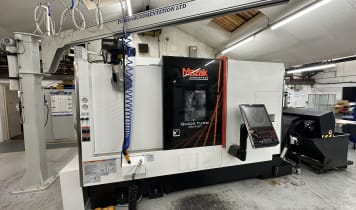A lathe consists of three main groups of components: frame, drive system and tool guidance system. The frame bears the weight of the mechanical components. They are built in a very solid fashion to enable the machines to withstand strong forces and work precisely. Welding constructions and monolithic cast metal frames are used, which increase device lifespan and ensure that a used metal lathe can be purchased without any structural concerns. Depending on the size of the metal lathe, the base may have to be adjusted in order to withstand the pressure and oscillating forces.
The second component group consists of an electrical motor and a gear unit. The gear unit chosen can range from a single-stage spur gear through to a high-performance torque converter for exceptionally quiet rotational movements. The spindle and tailstock also form part of the gear unit and are used to clamp the workpiece in position. Those who are looking to purchase second hand lathes should pay particular attention to the following areas: highly precise concentricity and a play-free tailstock are essential for precise workpieces. However, buyers of second-hand metal turning lathes may need to be willing to accept higher tolerances than in newer models under some circumstances. Overall, used lathe machines can still offer a considerable degree of stability.
Turning machines in operation
The third component, the tool guidance system, in the simplest versions consists of a rail along which the tools are fed using a turning spindle. If the purchase in question is a used lathe or turning machine, these components need to be checked carefully. Used metalworking lathes frequently come with a test log since they have already been in use. This log features information on concentricity and spindle play recorded at regular intervals. It is also possible for these key components to undergo a general overhaul. Various automated components may also be included depending on the design of the lathe, which guide the machining tools towards the rotating workpiece in accordance with a preconfigured programme. Nowadays, there are often options available for automatically switching tools and workpieces.
Lathes also require accessories and various equipments. The housing protects the area surrounding a lathe from chips and shavings cast off during the turning of metal and cooling lubricant is supplied to ensure uniform removal of chips from the workpiece. High-performance illumination enables the workpiece processing steps to be continually monitored. If the lathe machine is second-hand, accessories and attachments may be missing, or these may be optional parts. Even if the manufacturers are not obliged to keep a supply of accessories for old and second-hand lathes, the majority strive to offer a range of basic services for used machinery.



















































